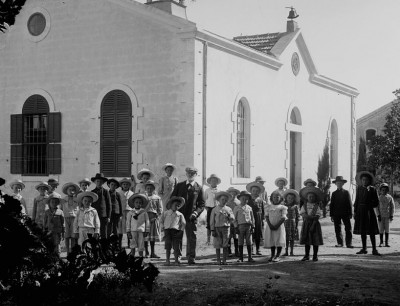When Israel Compensated Germans for Land in Palestine

Image: German Templers in Wilhelma, Palestine
Last month marked the 65th anniversary of the Nakba — the Palestinian catastrophe of 1948, during which Israeli forces expelled some 800,000 Palestinians from their homeland and seized their properties. In total, 536 cities, towns and villages — 78 percent of the land of historic Palestine — were taken during the 1948 war.
The Nakba is not just a historical event, however. It remains an ongoing trauma.
Palestinian human rights are assaulted daily; Palestinians still live under occupation or are barred from their homeland. Meanwhile, Israeli land and water confiscation continue — particularly in the West Bank and the Naqab (Negev) desert.
Palestinians worldwide remain excluded and uncompensated, despite Israel’s admission to the United Nations in 1949 being preceded by its expressed willingness to abide by Resolution 194, calling for the Palestinian refugees’ repatriation and compensation.
Little known, however, is that four communities in Palestine have received carefully evaluated and internationally arranged compensation for their losses. The four villages — Sarona, Wilhelma, Betlehem (not the famed Bethlehem) and Waldheim — belonged to a Christian German group called the Templers.
Model for settlers
Sarona near Jaffa was one of the first modern agricultural settlements in Palestine (1871) and was a model for Jewish settlers. Wilhelma (1902) near Lydda, and Betlehem (1906) and Waldheim (1907) in the upper Galilee were prosperous communally-owned German agricultural settlements.

A German colony in Palestine received compensation from the Israeli government when settlers were forced to flee during the Nakba. (Library of Congress)
The Templers maintained their German citizenship in Palestine. Although they established a Nazi party branch in Palestine during 1933, only approximately 17 percent of the Templers were Nazi sympathizers, according to Israeli scholar Yossi Ben Artzi. Still, most able-bodied Templer men were conscripted to fight in the German army in 1939.
During Second World War, the British Mandate government interned the German nationals in their rural villages. Some of the Templer families were then deported and interned inAustralia. Others became part of three British-German prisoner exchanges of Palestine-Germans for mainly Dutch Jews from the Bergen-Belsen concentration camps.
After the war, the British military guarded the four Templer villages to protect the Germans from Jewish extremists. Nevertheless, in April 1948, a Zionist attack killed at least two persons in Waldheim and resulted in many Templers fleeing. (This pattern of attack and killing to terrorize villagers and force them to leave was perpetrated on hundreds of Palestinian Arab villages by Zionist forces during the 1948 war.)
Fate diverges
The displaced Templers remained in Cyprus until they were admitted to Australia and became citizens (see Suzanne D. Rutland, “‘Buying out of the Matter’: Australia’s Role in Restitution for Templer Property in Israel,” Journal of Israeli History: Politics, Society, Culture, 24:1, 2005, pp 135-154).
Here is where the fate of the Palestinian refugees and the German Templer refugees diverge. The governments of Australia and West Germany worked together for ten years before the State of Israel agreed in 1952 to pay restitution to the German refugees for their four rural villages, as well as the Templers’ urban property holdings in Acre, Haifa, Jaffa and Jerusalem. A leading agricultural economist from Stanford University valuated the Templer holdings, including all real estate, their homes and farm buildings, orchards, forest and vineyards, down to the chicken coups and pigsties.
In 1962 — ten years later — the government of Israel paid 54 million Deutsche Marks to West Germany for the “German Secular Property in Israel” belonging to the displaced and dispossessed Templers, part of which was transferred to the Commonwealth of Australia (see Australian Treaty Series 1966 No 3).
Energetic campaign
How did the German Templers obtain compensation from the State of Israel for their expropriated property in Palestine?
The Australian and German governments mounted an energetic and determined international diplomatic campaign to secure compensation from Israel for the Templers’ assets. The Australian officials were persistent and convincing. They needed the capital inflows from restitution to assist in resettling the refugees.
Australia also assumed its obligation to protect its new citizens’ property rights. For their part, the Templers actively represented themselves through documentation, presenting evidence at international forums, and persistently demanding and claiming their rights before the Australian, German and Israeli governments.
The Templers lobbied their governments, showed up at international conferences to press their case, and advocated for themselves.
Unlike the Templers, diaspora Palestinians holding other citizenship have not been successful in obtaining compensation and restitution for their properties in present-day Israel. In 1949, educator Khalil Totah appealed repeatedly to the US State Department to assist him in obtaining compensation for his orange grove and lands in historic Palestine. “As an American citizen resident in the United States,” he wrote, “to whom should I turn for redress except to you?”
No public records exist of the US government attempting to obtain compensation for Totah’s or other American citizens’ property or assets seized by Israel during the 1948 war or after.
It is tragic and ironic that United Nations members remain complicit in the suppression of the Palestinians’ human rights. Even while some states applied significant diplomatic pressure to obtain compensation for displaced European settler communities in Palestine, which included a small but significant minority that sympathized and even fought for Nazi Germany, diplomatic pressure has not been expended for the indigenous Palestinians’ rights to Nakba compensation and restitution guaranteed under international law.
Rosemarie M. Esber is the author of Under the Cover of War: The Zionist Expulsion of the Palestinians. She is an independent researcher and international development consultant based in Washington, DC.

